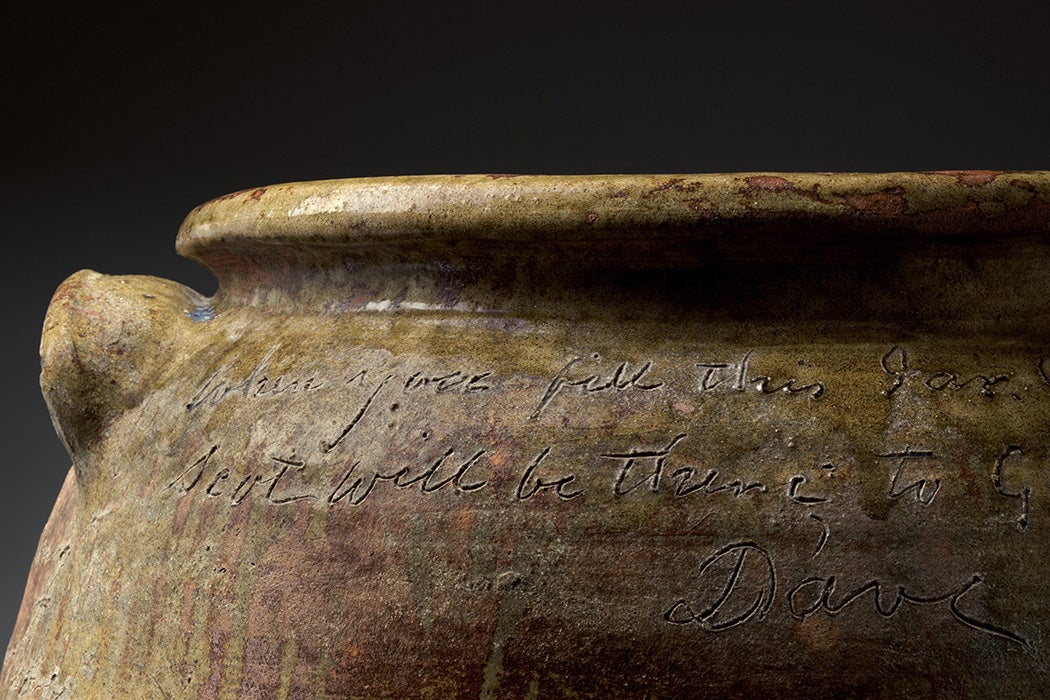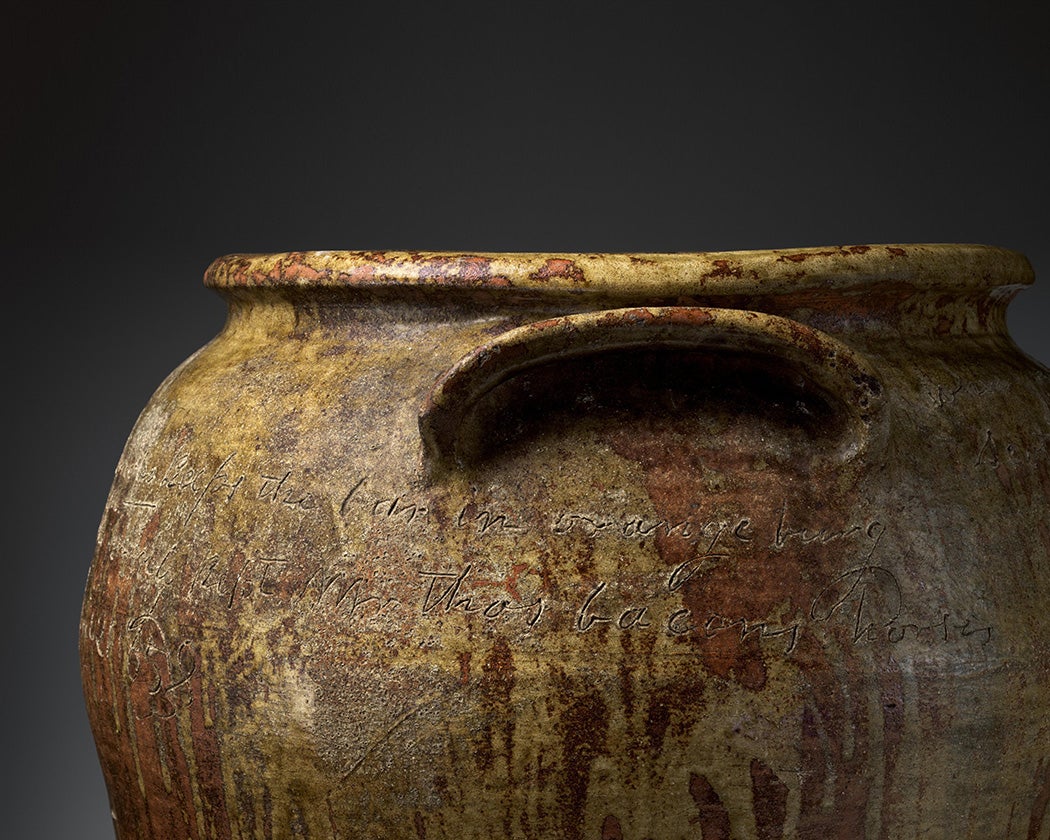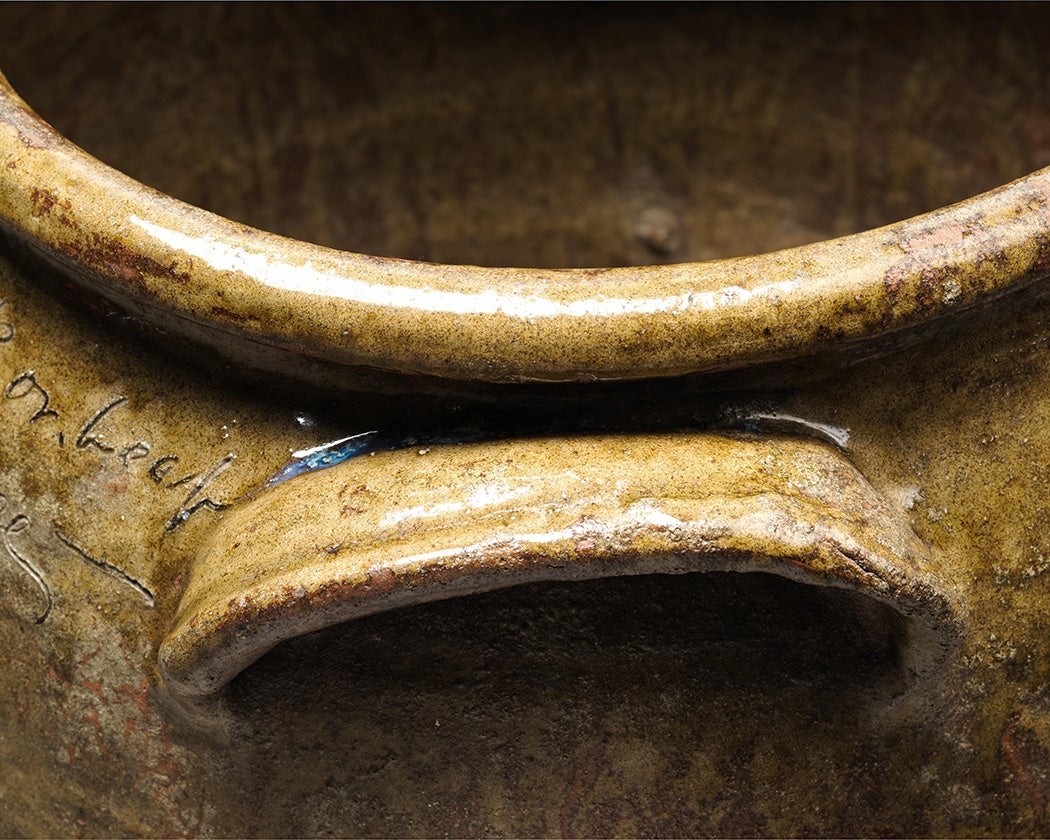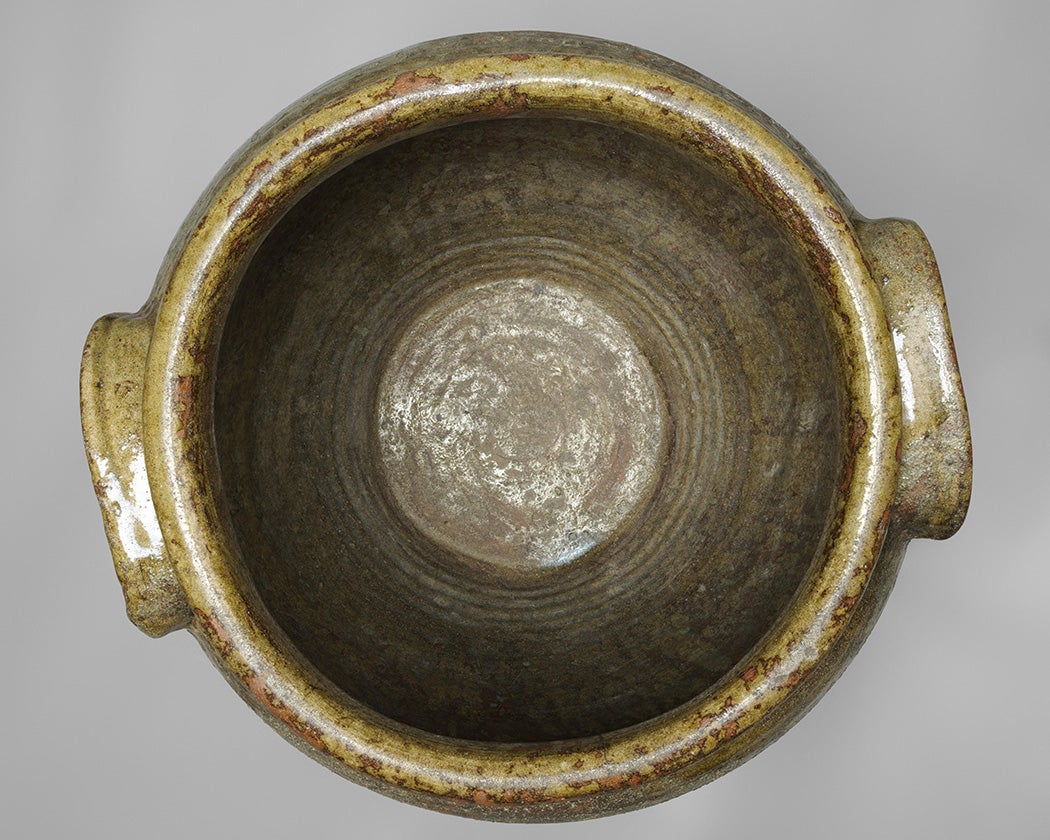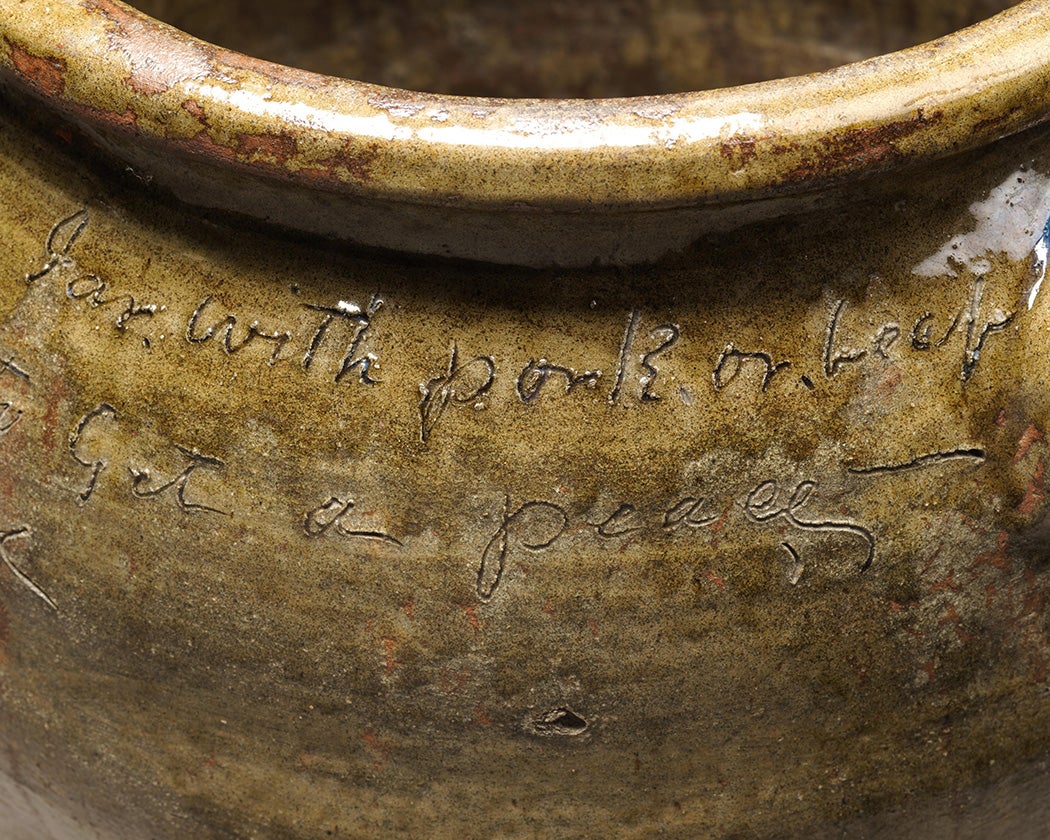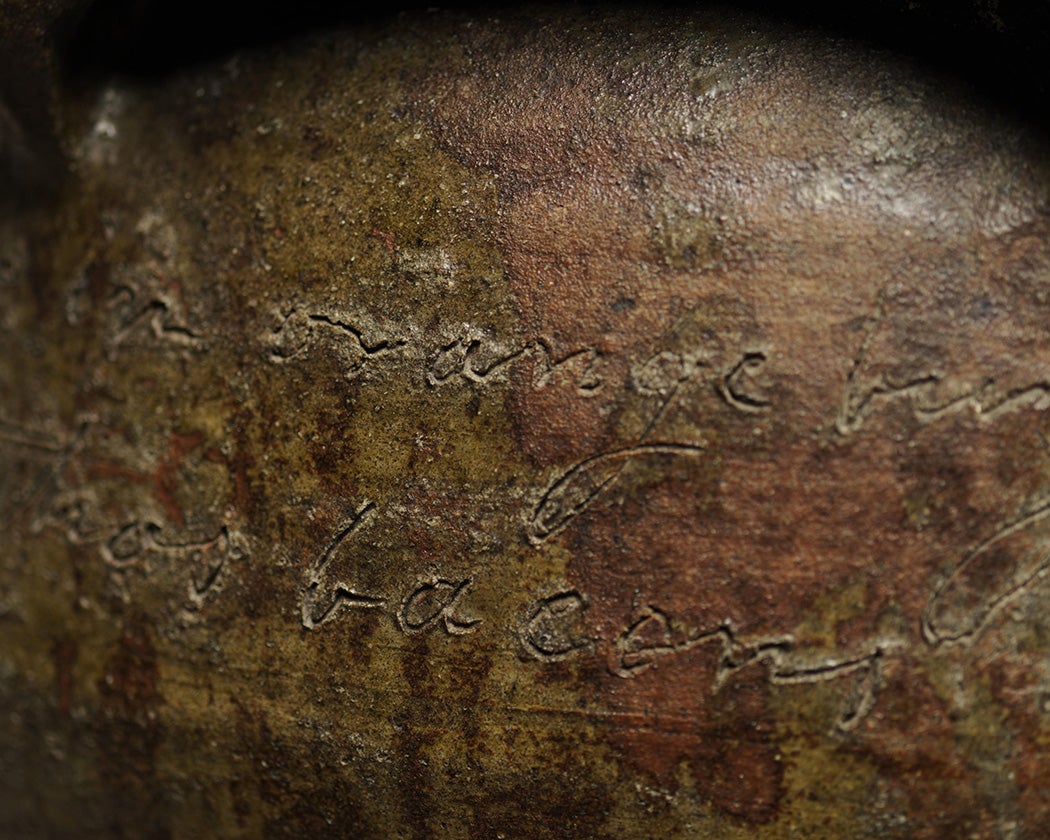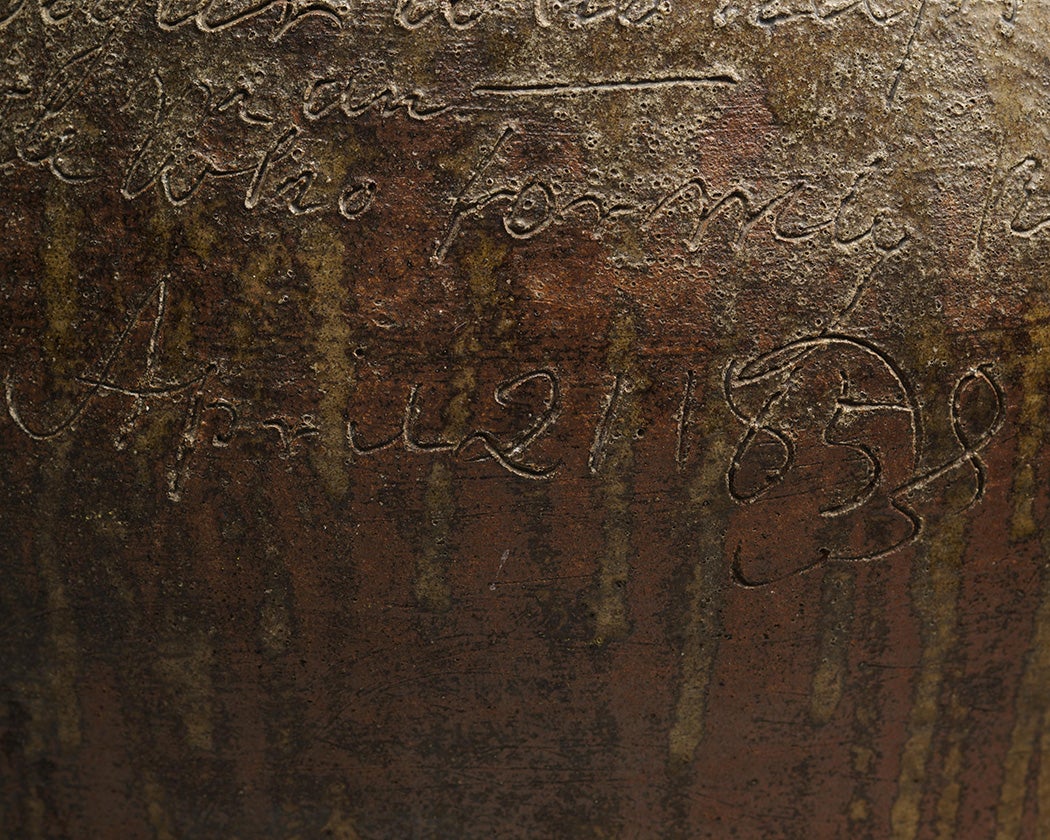From the trenches of the Antebellum South, enslaved potter David Drake (ca. 1801-1874), otherwise known as “Dave the Potter,” constructed hundreds if not thousands of functional pots while working on plantations and in factories in Edgefield, South Carolina, a region now famous for its ceramics. Dave was heralded for his enormous storage jars and for writing on his pots.
During the nineteenth century, life on some plantations revolved around pottery making: Jugs, jars, pitchers, and kitchen wares were generally made by hand, by the enslaved in the rural South. Most of the potters at this time, those who were enslaved as well as the white laborers who were not, did not inscribe or mark their work in any identifying way. Dave was different. He signed his name on the walls of his pots. He engraved markings, for example, such as forward slashes and circled X’s that may have been a way to keep inventory, or that hearkened to ancestral roots. Dave also wrote dates, the location where he fashioned the pots, lines of poetry, and Christian proverbs. All of these practices set him apart.
Weekly Newsletter
Beyond the imprints Dave intentionally made, his pottery bears other hallmarks of its time and origin: it is made of alkaline-glazed stoneware, which dominated the “Edgefield District,” as it was known, during Dave’s life. More specifically, alkaline is a type of ceramic glaze adopted in the South during the Colonial Era. Stoneware is the type of clay the pottery is made from, using local white kaolin clay and water from local sources like the Savannah River in conjunction with high kiln temperatures used in firing. Such stoneware was produced throughout the South, all the way down to Texas.
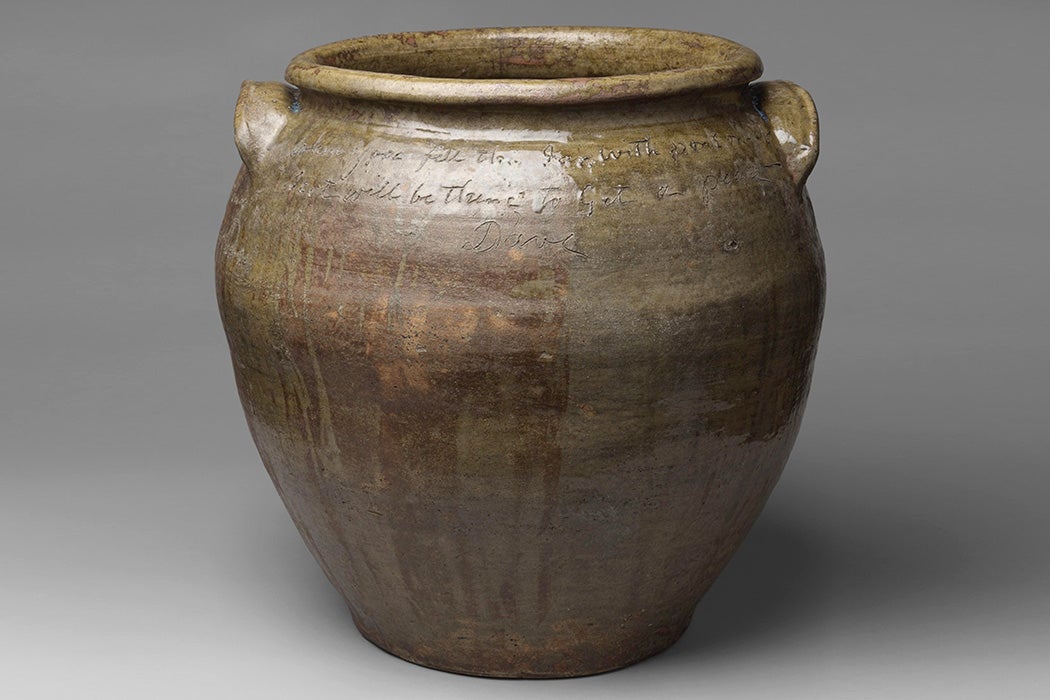
In North America, pottery making likely started in the Southeastern region around 4500 BCE. Archeologists have found remains of functional pottery across the coastal and shell-midden regions of South Carolina, Georgia, and Florida, where, writes Liz Tracey for JSTOR Daily, “mounds of shells tossed from consumed mollusks are found, sometimes with pottery, clothing, and plants mixed in.”
Before the Civil War, “the American pottery industry was dispersed geographically and struggled to compete against those greater economies of scale enjoyed by British manufacturers,” writes Christopher C. Fennell in The Archaeology of Craft and Industry. Yet, as plantation owners increasingly needed large vessels to store food and water for the enslaved, and to meet similar needs at surrounding plantations, they enlisted the enslaved to answer the demand. In doing so, they created the southern hubs of ceramic manufacturing—like Edgefield—that we know today. Dave Drake was one such laborer, Fennell writes, “owned by Harvey Drake and worked at a number of the Landrums’ potteries.” Indeed, Drake was a business partner of Abner Landrum, a plantation owner in South Carolina who also ran the local newspaper, Edgeville Hive.
Dave the Potter is said to have been born on a plantation in North Carolina, and shuffled between several enslavers in South Carolina before settling in with Lewis Miles in the Edgefield District from about 1849 until he gained freedom in 1865.
Around 1815, Landrum set up pottery factories in the Edgefield District, originating what is now famously known as Edgefield pottery. The working village—made up of twelve factories—likely benefited from an illegal slave transport in 1858 that “delivered 170 newly captive Africans to the Edgefield District,” writes Fennell. At that time, the transatlantic slave trade forbade importing Africans to be enslaved in the US.
Jill Beute Koverman explores the many unanswered questions surrounding Dave’s life in “The Ceramic Works of David Drake, aka, Dave the Potter or Dave the Slave of Edgefield, South Carolina.” Who taught him to read and write? Did he somehow teach himself? If so, how exactly?
What historians do know, they have pieced together through robust scholarly research and excavations. Dave was one of roughly seventy-five enslaved African and African American men and women who worked as a potter, or “turner,” in one of the potteries active in this area at the time. In Dave’s case, he did so for about six enslavers who were related to each other. In addition to Drake, Landrum, and Miles, they include Reuben Drake, Jasper Gibbs, and possibly the Reverend John Landrum. In the 1870 US Census, Koverman notes, there is documentation that Dave took on Harvey Drake’s surname after he was emancipated.
Dave is featured, along with some one hundred and fifty other enslaved potters, including Fortune Justice, Pharoah Jones, Shep Davis, and Mariah Day, in Hear Me Now: The Black Potters of Old Edgefield, South Carolina, an exhibition to open in late August at the University of Michigan Museum of Art, in Ann Arbor, having previously been hosted by Boston’s Museum of Fine Arts. Next winter the show will open at Atlanta’s High Museum of Art.
“[Dave’s] archive is incomplete, and some stories are speculative,” says Ethan Lasser, co-curator of the exhibition. “One pot is signed by ‘Mark and Dave.’ That could be his son, but we don’t know. He likely had a wife and children who were auctioned away in the 1850s based on a poem of his and inventories—there are some facts about his family that we can cobble together.”
Lasser points to one verse in particular that suggests Dave may have had a family: “I wonder where is all my relation/ Friendship to all—and every nation.”
Compared to the work of his contemporaries, Dave’s was epic. In general, the storage jugs in the Hear Me Now exhibition hold about three gallons. By contrast, Lasser notes, Dave’s hold twenty-five, twenty-eight, or even thirty gallons.

Dave’s pottery is remarkable in other ways too. “His writing was a public affair, vaunted by the same slave-owning class that so vehemently prohibited slave literacy,” writes Michael A. Chaney in an article in African American Review. He cites verses Dave inscribed:
“A storage jar from 1858 with two inscriptions contains a couplet (‘when you fill this Jar with pork or beef / Scot will be there; to Get a peace,— ‘) as well as a lengthy dedication: ‘this Jar is to Mr Seglar who keeps the bar in orangeburg for mr Edwards a Gentile man—who formerly kept Mr thos bacons horses’.”
Many scholars suggest that Dave’s inscriptions represent a protest against enslavement. As art historian Aaron De Groft says in “Eloquent Vessels/Poetics of Power,” “The literature concerning Dave is not wide ranging, and this idea of protest has never been investigated. However, such an examination reveals that Dave’s work does not fit neatly within the regional pottery tradition, nor does it fit exactly in the broader tradition of pottery and stoneware as once believed.”
De Groft notes three attributes of Dave’s work as arguable evidence of his protests. One is the sheer size of the vessels. Another, perhaps the most obvious, is that he wrote on his pots. And finally, the content of his verses may be inferred to invoke protest.
Dave did not use the exact same text on each pot. In the first known example, from 1834, he inscribed the word “concatination.” On a second pot, in 1836, he inscribed “catination,” which may, Chaney says, connect the vessels. That said, there is no clear explanation as to why Dave the Potter signed his work at all.
Lasser suspects that Dave’s writings underscore the use of a “double voice.”
“On one hand, you can read his poems as innocuous or humorous,” Lasser says. “On the other hand, he goes into some of the cruelties of the system that he lived in. Dave participated in what we call ‘industrial slavery.’ He was participating in a large industry where he worked along with and side-by-side other enslaved potters.”
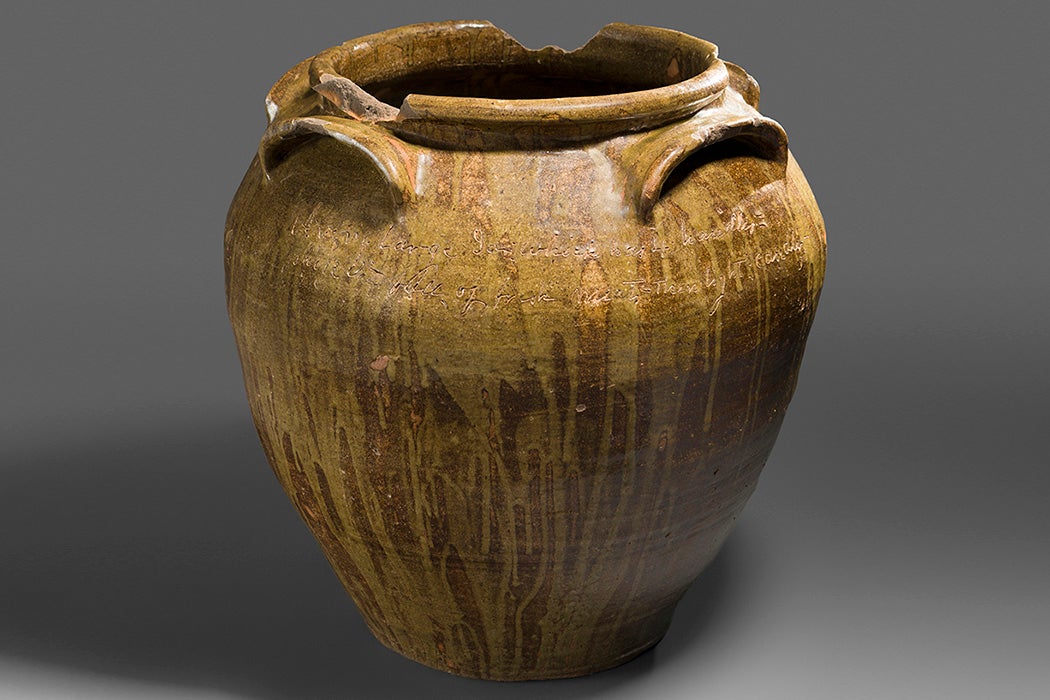
Hear Me Now includes contemporary ceramic work made by Black artists—a testament to the lasting inspiration the enslaved potters passed down to new generations.
In 1834, South Carolina “clamped down” on literacy of African Americans; the state passed a law forbidding anyone from teaching both the enslaves and free people of color how to read and write. However, the enslaved who were caught reading or writing were severely punished; authorities amputated fingers and toes. Some scholars believe that Dave was self-taught from learning the Biblical proverbs. “Religion and reading of the Bible was very common practice [during the nineteenth century], and [Dave’s] verses speak to that,” Lasser said. “He’s flouting that law: authorship is an act of resistance.”
The old Edgefield District’s pottery derived from many cultures. Koverman writes that the combination of European, African, and Native American traditions were “blended with Chinese glazing and firing technology to give birth to the alkaline-glazed stoneware tradition.” Indeed, African-derived markings on pottery wares is the only proof for archeologists to know if a clay pot, for example, was made by an enslaved person. Dave’s markings are in addition to his proverbs; some archaeologists have argued that eighteenth century handmade pottery was, in fact, made by Native Americans, and not by Edgefield potters.
All told, Dave is credited with making thousands of functional pots from June 1834 through 1866. Hear Me Now includes the vessel considered his earliest work, the 1834 pot bearing the word “concatination,” and a shard, dating to 1866.
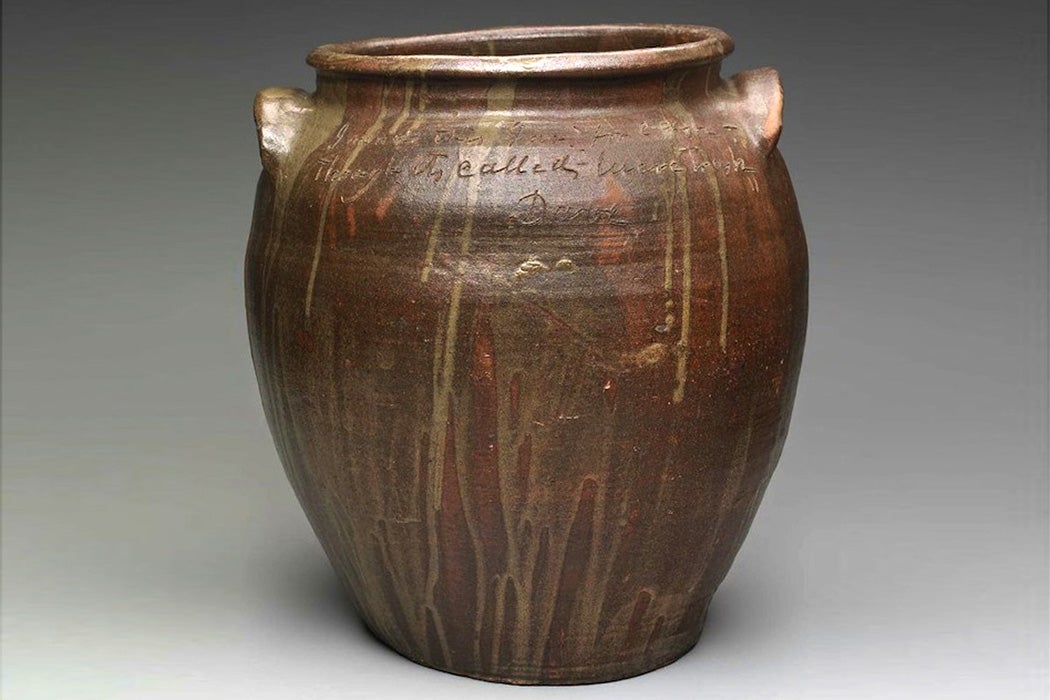
Dave’s works are included in many collections; some are signed “LM,” indicating that he made them during the time that Lewis Miles was his enslaver. Others, such as one from August 1840, read “Edgefield District,” a rarity as Dave did not typically inscribe locations. Still other pieces feature a combination of “Dave,” a date, location, and the initials “LM.”
We treasure nineteenth century Southern pottery far more now than we did when it was made. It was not made by “skilled” craftsmen, after all. It was produced by the enslaved, a fact which lowered its value. Also, it was not made from refined porcelain. What’s more, it was used by the enslaved.
“To the owners of the great Southern plantations, such crude ware was common, to be banished to the kitchen and slave quarters, and, quite naturally, all Southerners of any pretensions to gentility followed suit,” observes John Ramsay, author of American Potters and Pottery. “The result was that the potters, with no inducement to make any but the plainest and cheapest ware, omitted the decorative touches which not only add to the charm of pottery, but identify many unmarked pieces.”
In contrast to the ordinariness of most Southern pottery, Dave and a few other potters pursued their own vision. “The work of such potters speaks eloquently to their aesthetic intent; their bold, carefully turned forms, neatly balanced rims and handles, and rich, flowing glazes are a delight to the hand and the eye,” writes Charles Zug. “Such men were true artists in a world that did not recognize their work, yet they persisted in moving beyond necessity to create works of enduring beauty.”
Demand for pieces from the Edgefield District declined after the Civil War, as the use of manufactured pots grew. “The Temperance movement, factory-made metal and glass containers, and improved methods of refrigeration and transportation all combined to put many potters out of business,” Zug observes.
Weekly Newsletter
Dave’s fame eventually faded after he passed away, Lasser says. Archeologists became interested in studying his work after two of his pots with “Dave” inscribed on both were discovered in Charleston, South Carolina, during a research trip in the 1930s.
Still Dave the Potter was not forgotten. In 2016, he was inducted into the South Carolina Hall of Fame, Fennell says quoting the official record, “‘to recognize and honor both contemporary and past citizens who have made outstanding contributions to South Carolina’s heritage and progress.’”
